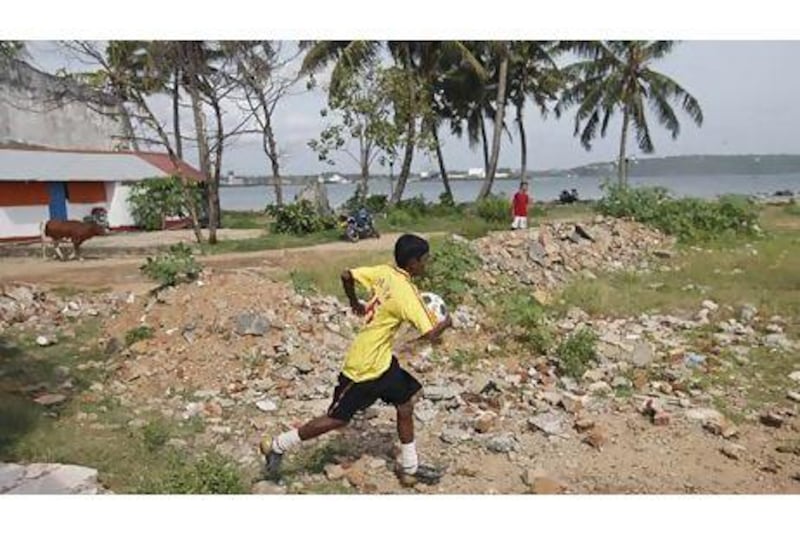From Serendip, an old name for Sri Lanka, comes serendipity, meaning the accidental discovery of something good or useful.
The word offers a good and useful, but incomplete, description of what some observers find when considering economic conditions on an island trying to forget two catastrophes, one natural and the other man-made.
Around the world, plenty of questions are raised about the way the regime of the president, Mahinda Rajapaksa, handles dissent. But analysis of the country's economy varies sharply, between those who - sometimes to their surprise - believe the government has made impressive strides and those with a much gloomier view.
The governor of the central bank, Ajith Nivard Cabraal, says the economy is stable, with steady progress on almost every macroeconomic front.
In an interview with The Sunday Leader, a newspaper that is often fiercely critical of the government, he said: "Even in the midst of the global turmoil, Sri Lanka has been maintaining a high growth while our external sector has been stabilising, with poverty, unemployment, reserve position and GDP growth being headed in the right direction."
Some indicators support the governor's view.
If tea production remains a major earner, people are another. On top of Sri Lanka's population of about 20 million, an estimated 1.8 million work abroad, mostly as labourers or maids in Arabian Gulf states.
The money they send home - the biggest single source of foreign currency - rose to more than US$6 billion (Dh22.03bn) last year.
Official statistics trumpet higher arrival figures for tourists, and the pro-government press talks of a country that is, in the words of the Daily News, "functional, brimming with hope [where], for the first time in decades, things are beginning to happen in an atmosphere of peace and security".
The reference to peace is important. The man-made catastrophe through which the country lived was nearly 30 years of civil war. That ended with the defeat of the Tamil Tigers in 2009. The natural disaster was the 2004 tsunami, which cost 40,000 lives in Sri Lanka and inflicted enormous damage around the coastline.
Both had significant economic consequences but the government believes it merits respect, which it is denied on matters concerning human rights, for its efforts to make the country viable.
But all is not as rosy as government supporters and the central bank governor suggest.
Last month, the IMF delivered a report that was at best mixed and at worst, based on some interpretations, "grim".
The IMF noted that public debt levels remained high and added: "Tax revenues have now fallen to below 11 per cent of GDP, among the lowest in the region, reflecting slowing activity, falling imports, exemptions and issues with tax administration."
Moreover, the IMF's forecast of 6 per cent growth this year is at odds with Mr Cabraal's more optimistic projection of 7.5 per cent.
Worrying signs have also emerged in some key sectors. Hoteliers have talked of dwindling occupancy rates, reflecting the misleading nature of higher arrival figures that include visits by members of Sri Lanka's large diaspora.
Luxury hotels have been hardest hit, as illustrated by a 22 per cent drop in the 2012 third-quarter earnings of the largest operator.
Along the tsunami-battered coastline, people whose living depends on tourism say times are hard.
A management source at Club Bentota, south of the capital Colombo in the heart of one of the areas most affected by the disaster, said bookings had dipped alarmingly for December on false fears of apocalypse inspired by some interpretations of the Mayan calendar. He added that there had been an encouraging recovery in January.
But other economic ills are proving hard to cure. Despite the government's attempts to combat poverty - with 2016 as the target for eradicating the problem - its own statistics show 1.8 million people are living below the poverty line, itself only 3,611 rupees (Dh104) a month.
Anecdotal observations help to demonstrate Sri Lanka's share of the world's lingering economic malaise - and an occasionally bewildering sense of priority. One online newspaper reader remarked wryly: "While the roads and streets are in darkness due to an electricity and energy crisis and road accidents have increased, the cricket matches are played at night under costly electric light."
In one undoubted setback for the island, export industries are struggling to cope with the loss of Generalised System of Preferences (GSP Plus) status that previously gave Sri Lanka advantageous access to European Union states.
The result has been reduced export orders and the closure or relocation of a number of factories. The loss of the status reflects EU concerns about alleged human rights abuses in the aftermath of the civil war.
Its effect is illustrated in one example cited by Sri Lankan media. A clothing manufacturer, Crystal Sweater Lanka, closed on January 2 with the loss of 1,100 jobs, saying it could not compete with countries such as Bangladesh and Vietnam, which still benefited from GSP Plus.
One western former resident, whose continuing visits to Sri Lanka make identification unwise, said the quashing of the Tigers had won Mr Rajapaksa the last election and he now seemed to be hoping he could pull off "the same PR campaign twice" and hope that the disastrous economy would be overlooked.
Not every observer would go that far - and some would flatly reject the bleak portrayal.
Among these conflicting signals, proper assessment of Sri Lanka's economy may occupy middle ground lying somewhere between serendipity and sadness, the latter symbolised by the shape and location of the island that gives it the nickname of India's teardrop.






